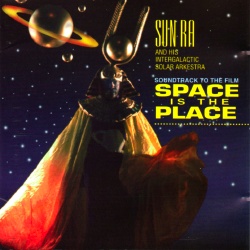
On Monday 6th of January we met at Birkbeck, Gordon Square, to watch and discuss Space is the Place (1974) by Sun Ra.
Due to unforeseen technical difficulties we moved from the Birkbeck Cinema to the Keynes Library to watch the film and remained there for the discussion afterwards.
The film narrates the return to Earth of mysterious musician and prophet figure, Sun Ra, with a mission to persuade African Americans to return with him to his planet. The plot is accompanied and interspersed with music by Sun Ra and his Arkestra.
Unfortunately we were delayed beginning the film because of the aforementioned technical difficulties and so our discussion afterwards was curtailed to a mere half an hour. However, the discussion was lively and stimulating, though I’m sure we could have continued for much longer. Below is a summary of some of the issues we discussed, separated into themes:
Race/Gender
We began with a couple of reservations about the representation of women in the film. Though the film pushed against racial exploitation it did not do so for gender exploitation. Further, though the film highlighted the plight of black people, this was geographically limited to the experience of African Americans.
Blackness as a concept was a subtle and complex phenomenon in the film. At first blackness appears to be a specific term referring to a specific race. However, as the film progresses the concept becomes more elastic. A Hispanic character enters Run Ra’s spaceship while another black character must leave his ‘white’ half behind in order to join. It was suggested that blackness here might equate with the term political blackness stretching the term to those who are similarly oppressed by racism.
Genre
The film’s mixing of many different genres was commented upon. The fantastic elements can be viewed as sf or magic realism, while much of the imagery and structure were taken from myth and religion. This mixture was described by someone as an example of early ‘remix culture’.
The mythic elements, taken from Ancient Egypt, were noted and read as a reclamation of a history and myth cycle appropriated by the West. It was noted that this appropriation and process of reclamation are ongoing in popular culture; Janelle Monáe’s line ‘Gimme back my pyramid’ was mentioned from her song ‘Q.U.E.E.N’ (The Electric Lady, 2013).
Myth was further described as a political intervention, especially in connection with the scene in which Sun Ra visits a youth center. The insertion of myth into reality here functions to challenge and change reality.
Design
The design of costumes, props, and scenery were praised and interpreted for their symbolism. The spaceship came in for the most comment; it was seen as a repost to the phallic symbolism of sf spaceship imagery, figuring either as breasts or as an assortment of erogenous zones. It was suggested that the spaceship design was an attempt to wrest the possibility of outer space from government space agencies such as NASA.
The Ancient Egyptian costumes were felt to highlight and estrange mundane elements of everyday clothing such as sunglasses or shoes. The sunglasses in particular were seen to clash in certain ways with the ritualistic costumes, while at the same time the juxtaposition questioned their use and meaning. Sunglasses here were linked to their function in cyberpunk (the mirrorshades ubiquitous to the genre) and to their formulation in Breakfast of Champions (Kurt Vonnegut, 1973) as windows to alternative realities.
We also discussed the scenes set on an alien planet, which open the film. It was pointed out that these scenes referenced the Arcadian imagery of landscape paintings, which normally exclude non-White bodies. Here Sun Ra can be seen creating a pastoral idyll for black people and questioning the exclusion of certain bodies within art.
Music
It was argued that the music included in the film was the most sf element of all, estranging the audience from the visual cues set up in the film. The universality of language is contrasted with the extra-linguistic form of music, making strange those elements of conventional narrative. The music, in fact, marked a boundary beyond hegemonic language in which the marginalized could be free. Kodwo Eshun’s term “sonic fictions” was mentioned, as was the context of 1970s experimental jazz.
Another context mentioned in the discussion was a short story by Henry Dumas ‘Will the Circle be Unbroken’ (in Ark of Bones and Other Stories, 1974) in which white music critics enter a black jazz bar and are killed by the vibrations of the music. It was suggested that this was alluded to in a scene early on in the film set in 1943 in which Sun Ra’s piano playing destroys a jazz bar.
Leave a Reply